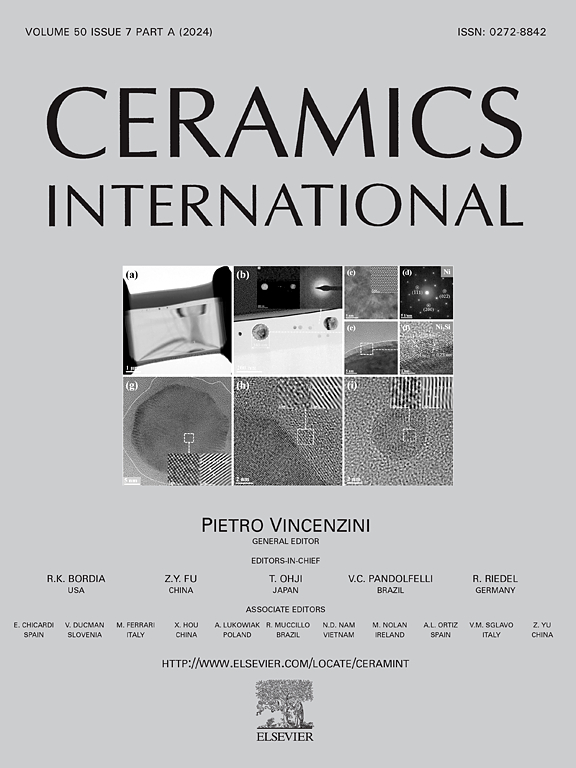Insights into the origins of conductivity enhancement in graphite-like carbon/ZnO:C hybrid ceramics prepared via carbothermal reduction: An XPS investigation
IF 5.1
2区 材料科学
Q1 MATERIALS SCIENCE, CERAMICS
引用次数: 0
Abstract
In this study, the carbothermal reduction (CTR) technique was employed to incorporate carbon atoms into the ZnO matrix. X-ray photoelectron spectroscopy (XPS) measurements on the sputter-cleaned cross section of the reduced sample revealed that most carbon atoms were arranged in a highly conductive sp2 graphite-like (GLC) configuration. The formation mechanism of GLC within the pores, along with the effects of temperature and pressure on this process, was studied using thermodynamic calculations. In addition to the formation of GLC, the CTR reaction was found to facilitate the substitution of C dopants at both Zn and O sites. The effects of C incorporation on charge transport properties were also investigated. The electrical conductivity of the GLC/ZnO:C ceramic reached 2.39 S/cm, which was nearly 6000 times higher than that of the undoped ZnO ceramic. These findings provide valuable insights into the chemical composition and enhanced electrical conductivity of carbothermally reduced ZnO ceramics. Furthermore, they elucidate the effects of carbon contamination on the chemical and electrical properties of ceramics fabricated in close proximity to external carbonaceous sources, such as graphite molds used in spark plasma sintering (SPS).
通过碳热还原法制备的类石墨碳/ZnO:C杂化陶瓷电导率增强的来源:XPS研究
本研究采用碳热还原(CTR)技术将碳原子掺入ZnO基体中。x射线光电子能谱(XPS)测量了溅射清洗后还原样品的横截面,发现大多数碳原子以高导电性的sp2类石墨(GLC)结构排列。利用热力学计算方法研究了孔隙中GLC的形成机理,以及温度和压力对这一过程的影响。除了形成GLC外,CTR反应还促进了Zn和O位点上C掺杂物的取代。研究了C掺入对电荷输运性质的影响。GLC/ZnO:C陶瓷的电导率达到2.39 S/cm,是未掺杂ZnO陶瓷的近6000倍。这些发现对碳热还原ZnO陶瓷的化学成分和增强的电导率提供了有价值的见解。此外,他们阐明了碳污染对靠近外部碳源(如火花等离子烧结(SPS)中使用的石墨模具)制造的陶瓷的化学和电学性能的影响。
本文章由计算机程序翻译,如有差异,请以英文原文为准。
求助全文
约1分钟内获得全文
求助全文
来源期刊

Ceramics International
工程技术-材料科学:硅酸盐
CiteScore
9.40
自引率
15.40%
发文量
4558
审稿时长
25 days
期刊介绍:
Ceramics International covers the science of advanced ceramic materials. The journal encourages contributions that demonstrate how an understanding of the basic chemical and physical phenomena may direct materials design and stimulate ideas for new or improved processing techniques, in order to obtain materials with desired structural features and properties.
Ceramics International covers oxide and non-oxide ceramics, functional glasses, glass ceramics, amorphous inorganic non-metallic materials (and their combinations with metal and organic materials), in the form of particulates, dense or porous bodies, thin/thick films and laminated, graded and composite structures. Process related topics such as ceramic-ceramic joints or joining ceramics with dissimilar materials, as well as surface finishing and conditioning are also covered. Besides traditional processing techniques, manufacturing routes of interest include innovative procedures benefiting from externally applied stresses, electromagnetic fields and energetic beams, as well as top-down and self-assembly nanotechnology approaches. In addition, the journal welcomes submissions on bio-inspired and bio-enabled materials designs, experimentally validated multi scale modelling and simulation for materials design, and the use of the most advanced chemical and physical characterization techniques of structure, properties and behaviour.
Technologically relevant low-dimensional systems are a particular focus of Ceramics International. These include 0, 1 and 2-D nanomaterials (also covering CNTs, graphene and related materials, and diamond-like carbons), their nanocomposites, as well as nano-hybrids and hierarchical multifunctional nanostructures that might integrate molecular, biological and electronic components.
 求助内容:
求助内容: 应助结果提醒方式:
应助结果提醒方式:


